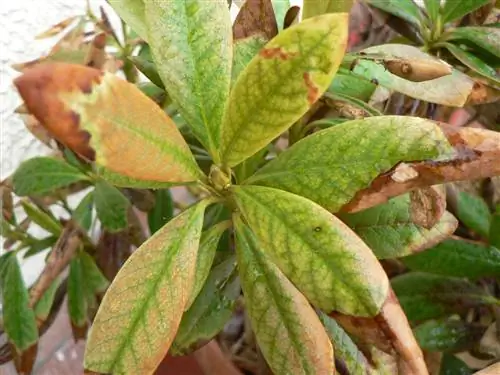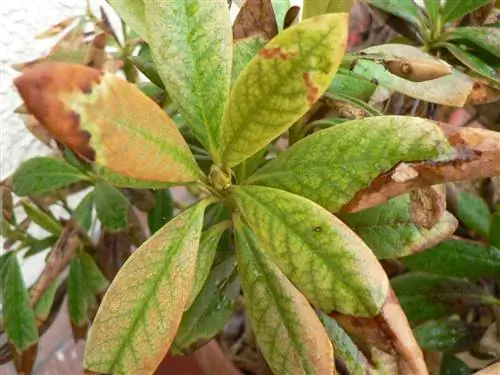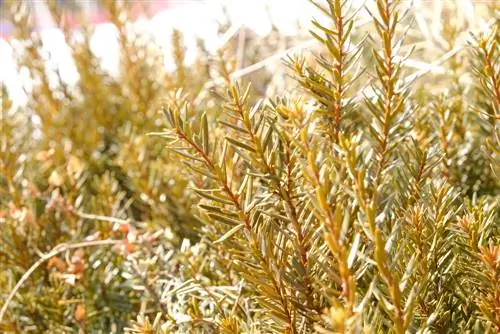- Author admin [email protected].
- Public 2023-12-16 16:46.
- Last modified 2025-01-23 11:22.
Spotty, brown or yellow leaves on rhododendrons can indicate various causes. In many cases, a fungus is responsible for the damage. To prevent it from spreading in the first place, the choice of location and balanced care are of great importance.

Which fungal diseases are common in rhododendrons?
A rhododendron can be affected by various fungal diseases such as powdery mildew, leaf spot, rhododendron rust, bud dieback and shoot dieback. To prevent fungal infestation, you should pay attention to balanced care, suitable location and ventilation.
These are common fungal diseases:
- Powdery mildew: caused by fungal species such as Erysiphe cruciferarum, Sphaerotheca pannosa or Microsphaera alni
- Leaf spot disease: collective name for species such as Glomerella, Cercospora, Pestolotia and Colletorichum
- Rhododendron Rust: arises from various species of the order Pucciniales
- Bud dieback: as a result of an infestation by Pycnostysanus azaleae
- Shoot death: caused by Verticillium dahliae and albo-atrum
Powdery mildew
This fungus causes a grayish and mealy coating that covers leaves and stems. Inadequate ventilation and warm, dry conditions promote spore growth. Cut out the affected areas generously and spray an aqueous milk solution in a ratio of 8:1 onto the entire plant. After leaving it on for 20 minutes, rinse off the residue. Repeat the treatment two to three times. The lecithin contained in milk kills the fungal spores.
Leaf spot disease
There are more than 20 different species of fungi that can cause this disease. They spread in damp weather and cause patchy discoloration, which, as they spread, leads to leaf loss and stunts growth. To prevent an infestation, you should choose a good location for the rhododendron. Do not place the ornamental shrub in areas that are too shady.
Rhododendron Rust
Rust fungi rarely occur on rhododendrons and cause yellowish to orange spore deposits on the underside of the leaves. They are easily confused with leaf spot, as this manifests itself in different discolorations. To prevent fungal infestation, you should regularly fertilize the ornamental shrubs and water them at the base of the plant.
Bud dying
Small injuries in plant tissue create entry points for fungal spores. Brown-colored buds that wither over the course of the winter are typical. Evergreen varieties are more commonly affected by this disease. In March, cut out all dead plant parts and strengthen the plant with liverwort or algae extracts. Since this fungus is probably transmitted by the rhododendron leafhopper, you should control this pest.
Instinct death
Azaleas are often affected by this disease, in which first leaves and later shoots hang limply. The fungus clogs the pathways so that the plant can no longer supply its foliage. A spray with manure made from field horsetail, wormwood, comfrey, tansy or nettles strengthens the plant. If the fungus has established itself in the roots, the perennial can no longer be saved and must be cleared.
Tip
This disease is known by various names such as Phytophtora or Verticillium wilt. However, the damage patterns and approaches to combating them do not differ.






